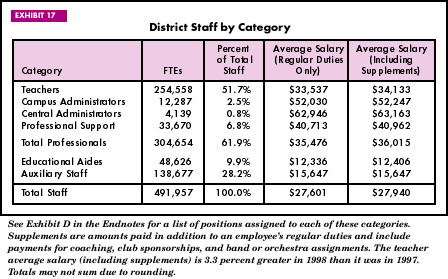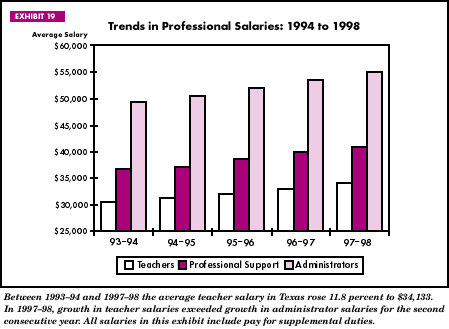
Staff CountsTeachers Teachers are the largest single category of employees of public school districts, accounting for 83.6 percent of the professional staff and 51.7 percent of the total staff. See Exhibit 17 below. Teacher full-time equivalent (FTE) counts increased by 2.8 percent, which compares with a student enrollment increase of 1.6 percent from the previous year. Student growth rates vary across districts and grades, requiring districts at times to hire additional teachers for less than full classrooms. Statewide, a new teacher FTE is added for approximately every nine new students.
Rates of teacher increases vary with the size of the district. Districts in all size categories hired teachers at a rate greater than their respective average enrollment growth rates, thereby reducing their average student/teacher ratios. The nine districts with enrollment greater than 50,000 hired new teachers at the lowest rate, one new teacher for every 16.2 new students. Districts with enrollment between 1,000 and 1,600 hired new teachers at the highest rate, one for every 4.1 new students. Support and Administrative Staff The combined categories of administrators and professional support staff increased by 4.4 percent between 1996-97 and 1997-98, a rate significantly higher than the 2.8 percent rate of growth demonstrated in the teacher population. Professional support staff increased by 5.3 percent. Campus administrative staff grew by 4.3 percent and central administrative staff decreased by 1.6 percent. Professional support staff increased at more than twice the rate of enrollment growth within all district groups, except for the group of the nine largest districts. Districts with 500 to 1,000 students experienced the greatest growth rate in professional support staff, 10.4 percent, although this equated to less than one full-time professional support person per district. The nine largest districts experienced the lowest growth rate, 2.4 percent, averaging 20 new professional support FTEs per district. Central administrative growth rates exceeded enrollment growth rates in only two of the nine district size categories, with the greatest growth occurring in the group of 68 districts with enrollment between 5,000 and 10,000 students. In six of the nine district size categories, the number of central administrative staff declined. Campus administrative growth rates exceeded or equaled enrollment growth rates in all district size categories. Non-Professional Staff The number of educational aides increased dramatically, by almost 14 percent this year. This follows a year of slight decline (0.8 percent) between 1995-96 and 1996-97. The increase in the number of aides is most prevalent in major suburban districts, where an additional 1,557 educational aides were hired. In 1997-98, aides employed at junior high and high schools increased by over 25 percent over the previous year. Aides employed by elementary schools experienced the smallest increase among school types-10.8 percent. Only a small portion of the staff employed as educational aides will advance to teaching positions. During 1997-98, approximately 2,263 teachers (less than one percent of the total teaching staff) had been employed as aides sometime between 1994 and 1997. Auxiliary staff, the second largest staff category at 28.2 percent of all staff, increased by less than 0.1 percent this year, compared with an increase of 4.5 percent the previous year. Auxiliary staff include secretaries, bus drivers, maintenance workers, and cafeteria workers. The largest increases occurred in the 24 districts with enrollment between 25,000 and 50,000 students. In five of the nine size categories, the number of auxiliary staff declined. The ethnic composition of school district employees changed only slightly from the previous school year. Minority staff increased by one-half percent to 35.9 percent of all staff employed in Texas public schools. This can be disaggregated to 24.0 percent Hispanic, 11.0 percent African American, and 0.9 percent Asian/Pacific Islander and Native American. Among teachers, approximately 24.8 percent are minorities, up slightly from the 24.4 percent minority reported for the previous academic year. Given this slight increase, ethnic minority recruitment into education careers merits continued emphasis. Teacher ExperienceTeachers employed in Texas in 1997-98 averaged 11.8 years of total experience. This statistic has experienced a steady, but slow increase from an average of 11.0 years in 1988-89. Over 20 percent of all teachers have more than 20 years experience and 44 percent have between 1 and 10 years of experience. In 1997-98, new teachers accounted for 7 percent of the total, a slight increase from the previous year. Teachers at high schools continue to be more experienced--12.9 years on average--compared to elementary school teachers with an average of 11.6 years of experience. The lowest average years of teacher experience exists in junior high schools--10.9 years. Districts with greater enrollment growth continue to have lower average teacher experience, indicating that new, rather than experienced, teachers are more often hired to meet the increased demand. Teacher CredentialsTo teach in public schools in Texas, individuals must earn appropriate certification by satisfying a combination of education, experience, and test requirements that vary depending upon the certification route pursued. Information about teacher certification, testing requirements, and the Alternative Certification Program (ACP) is available from the State Board for Educator Certification. This agency, created in 1996 by the 74th Texas Legislature, oversees nearly 255,000 practicing educators across the state and is responsible for all functions related to the preparation, assessment, certification, continuing education, and investigation and sanctioning of education professionals. Education As shown in Exhibit 18 below, the highest degree obtained by the majority of teachers in Texas (73.0 percent) is a bachelor's degree. An additional 26.0 percent have earned master's or doctoral degrees. Although larger districts continue to employ a larger proportion of teachers with advanced degrees, the gap between large and small districts diminished this year. The percent of teachers with advanced degrees held at 32.0 percent in the nine largest districts, but increased in the smallest districts from 18.8 to 26.0 percent. Overall, the percentage of Texas teachers with advanced degrees continues to decrease. Since 1988-89, this percentage has declined from 32.7 to 26.0, with one percentage point of this decline occurring in 1997-98. Of the teachers with advanced degrees, 52.5 percent are employed in the 71 urban and major suburban districts; 47.5 percent work in the 990 remaining school districts.
Permits Educators who have not yet earned the appropriate certification may be granted one of five types of permits in order to perform their assigned duties: nonrenewable, temporary classroom assignment, temporary exemption, emergency, and district teaching. Each of these permits allows a person to be employed in the public school system for varying lengths of time. All but the district teaching permit are for individuals who seek to achieve the appropriate certification but are currently lacking in some credential. The district teaching permit, which must be approved by the commissioner of education, is for degreed individuals who do not hold any type of teaching credential. The district teaching permit remains valid as long as the individual seeking the permit is employed in the district. Statewide, 4.0 percent of teachers hold an active permit of some type. The percentage of teachers holding permits varies by subject area and student population served. Excluding the area of regular education, the three areas with the greatest proportion of teachers holding permits are bilingual education, special education, and English as a second language (ESL). The U.S. Department of Education currently includes bilingual/ESL and special education among the designated teacher shortage areas in Texas. Other shortage areas are science, mathematics, and foreign language. Teachers in these areas are eligible for loan deferments or a reduction in the length of their teaching obligation under federal loan and scholarship programs. Professional SalariesTeacher Salaries In 1997-98, average teacher salaries (for regular duties) increased by 3.4 percent to $33,537. Total average teacher salaries, including reported supplements, climbed to $34,133, a 3.3 percent increase. "Total salaries" refers to pay for regular duties plus any supplemental pay employees earn for additional duties such as coaching, club sponsorships, and band or orchestra assignments. Pay for regular duties is not the same as the state mandated minimums, as it includes local enrichment amounts districts pay above the minimum salaries specified in statute. Most of the employees who earn supplemental pay are teachers. In the past, the difference between the teacher average total pay and pay for regular duties was much greater than it is now. In 1994-95, average total teacher pay was $1,771 greater than the average for regular duties. This difference was due primarily to supplemental pay for teachers who were on the teacher career ladder. With the end of the teacher career ladder allotment, pay previously reported as supplemental became a part of a teacher's regular pay amount. This event explains the resulting significant increase in average regular duty pay that took place between 1994-95 and 1995-96. In 1997-98, the gap between teacher average total pay and regular duty pay declined to $596. A minimum salary schedule for classroom teachers and full-time librarians is specified in statute. This schedule requires that minimum salaries rise as the years of experience of the employee increase. In 1997-98, the minimums required ranged from $2,105 per month for those with no experience to $3,746 per month for those with 20 or more years of service. These monthly salary amounts are based on a standard 10-month contract. National Comparisons According to the 1998 Digest of Education Statistics, Texas average teacher salaries ranked 35th among the states in 1997-98. The average salary for Texas teachers was 14.6 percent below the national average of $39,385. However, the salary that Texas teachers earn is closely linked to their years of teaching experience. Because the average experience level of teachers varies from state to state, average salaries are likely to be higher in states with more experienced teachers. In addition to differences in teacher experience among states, cost-of-living differences explain some of the national variation. According to the American Federation of Teachers, in 1996-97, the most recent year available, Texas ranked 38th in teacher salaries. However, when cost-of-living was considered, Texas moved to the 29th rank. As reported in the 1998 Digest of Education Statistics, the pupil-teacher ratio in Texas remains lower than the national average--15.5 compared with 17.1 nationally in 1996-97. Texas law mandates a maximum class size of 22 to 1 in kindergarten through grade 4. The expense of maintaining smaller class sizes appears to limit the ability of Texas districts to compensate teachers with higher salaries. Of the 34 states with salaries higher than those in Texas, 26 (76 percent) also had higher pupil-teacher ratios in 1996-97. Salaries by District Type Analysis of teacher salaries by size and type of district indicates the greatest increase in teacher salaries occurred in districts with an enrollment less than 500 students. Teacher salaries in the larger districts grew at rates less than the state average. Though the rate of salary increase was greater in much smaller districts, major urban districts still pay teachers more on average than do rural districts. In 1997-98, teacher salaries in urban districts were 9.4 percent higher than in rural districts. Cost-of-living differences between urban and rural areas explain some of this variation. Districts classified as non-metro "fast growing" pay the least among all district types, perhaps because they have the least experienced teachers on average. Other Staff Salaries Campus administrator and professional support staff salaries exhibited a 2.6 percent increase in 1997-98, while central administrator salaries increased by 4.4 percent. Including supplements, central administrators earn an average of $63,163, campus administrators $52,247, and professional support staff $40,962. Overall, the combined regular duty salaries for all categories of professional staff (teachers, professional support, and administrators) increased by 3.3 percent, to $35,476, from the 1996-97 school year. Total salaries, including reported supplements, climbed to $36,015, a 3.2 percent increase. Exhibit 19 below, depicts trends in professional salaries by category of staff since 1993-94.
|


